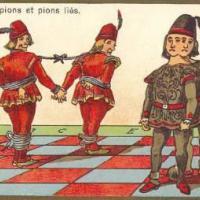
The Arch-Arch Nemeses: Connected Passers
Today we will look at bishop vs. knight endgame where one or both sides have connected passed pawns. Two examples feature an extra two pawns in these endgames and as we will see, having two extra pawns does not necessarily guarantee a win. The third example that we will look at features pawn races- both sides have connected passed pawns and the question is: who is faster? Usually the side with the central pawns has the advantage because they are harder to stop. We will see this statement reappearing in the examples shown below.
Black is up two pawns in this bishop vs. knight endgame. The pawns are reasonably far advanced and both the king and knight are helping the pawns to advance. White defensive potential is high as the king and bishop are trying to stop the pawns. White's main defensive idea is to sacrifice the bishop for the two pawns and around this idea he bases his defense.
Usually two pawns should be enough to win but in this position there are two disadvantages that will hurt black's chances for a win. The first one is that the pawns are on the edge of the board. If the pawns are in the centre black can defend both pawns from either side. In this position black's a-pawn cannot be defended by the black king and it pins the knight to the defense, which is the second disadvantage of black's position. Given these two disadvantages whites manages to successfully defend. Tactically, black threatens to play a4 after which his position will be winning because there would be no way to stop the a-pawn. White can attack the b-pawn so the a-pawn will not be able to move.
In the next example white is up two pawns but black has some pawns too. The d-pawns are doubled which reduces white's advantage. Black has a passed b-pawn, which might become dangerous if black pushes it far enough. For now black created some kind of fortress, and it is not easy for white to break through. So white temporarily sacrifices a pawn but gets to the e5-pawn. In the end you will see a similar scenario to the first example but with an extra pawn for black and the knight and bishop reversed. Because white has central pawns and a bishop supporting them, black's defense collapses almost right away.
The last example is a masterpiece by chess.com editor and contributor IM David Pruess. Black has a centralized king and well-placed knight. His central pawns are more advanced than white's pawns. White's main disadvantage is a poorly placed king and main advantage a bishop. The position is open so white will be able to utilize the full potential of the bishop. The question is who is faster in the pawn race? Another question is which pawn to move for black? He can either move the knight away and push the d-pawn or move the king away and push the e-pawn. The d-pawn is more advanced and at first sight it seems that this is the right pawn to push but by doing so one has to move away the knight, which is ideally located on d3.
We looked at three examples of bishop vs. knight endgames with passed pawns. In the first example the position was a draw because of the awkward knight placement and because the pawns were a- and b-pawns, which is usually a disadvantage compared to the central pawns. The second example clearly showed why having central pawns helps in winning. And the last game was a complex fight where both sides had passers but black had an advantage of central pawns and centralized king. With the next article we will continue the series on the Arch-Arch Nemeses.






